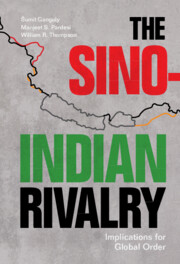Book contents
- The Sino-Indian Rivalry
- The Sino-Indian Rivalry
- Copyright page
- Contents
- Figures and Maps
- Tables
- Acknowledgments
- Part I Introduction
- Part II Spatial and Positional Considerations and Violence
- Part III The Evolution of the Rivalry
- Chapter 5 Crises in Sino-Indian Relations
- Chapter 6 Asymmetries and Rivalry
- Part IV Interconnected Rivalries and Systemic Considerations
- Part V Conclusion
- Bibliography
- Index
Chapter 6 - Asymmetries and Rivalry
Economic, Nuclear, and Naval
from Part III - The Evolution of the Rivalry
Published online by Cambridge University Press: 15 June 2023
- The Sino-Indian Rivalry
- The Sino-Indian Rivalry
- Copyright page
- Contents
- Figures and Maps
- Tables
- Acknowledgments
- Part I Introduction
- Part II Spatial and Positional Considerations and Violence
- Part III The Evolution of the Rivalry
- Chapter 5 Crises in Sino-Indian Relations
- Chapter 6 Asymmetries and Rivalry
- Part IV Interconnected Rivalries and Systemic Considerations
- Part V Conclusion
- Bibliography
- Index
Summary
Multiple asymmetries characterize the Sino-Indian rivalry. India’s slow and fitful (absolute) rise over the past three decades has happened in the context of relative decline vis-à-vis China because the latter has grown faster and more comprehensively. Despite this asymmetry, newer functional areas – economics, nuclear, and naval – have appeared in this contest. These areas are riddled with domain-specific asymmetries and domain-specific pathways to conflict escalation. While there is no reason to believe that war is inevitable, the Sino-Indian relationship has entered a troubled phase because further asymmetry as well as strategies to address these asymmetries are both conflict-prone. There are three specific pathways (which are not mutually exclusive) that cut across these different domains and point towards heightened conflict: any Chinese attempt to create a new status quo reflective of the power gap in its favor; any Indian endeavor to redress this power gap in order to be taken more seriously by China; and the United States’ promotion of the rise of India.
- Type
- Chapter
- Information
- The Sino-Indian RivalryImplications for Global Order, pp. 123 - 154Publisher: Cambridge University PressPrint publication year: 2023

